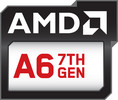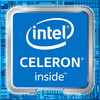AMD A6-9220C vs Intel Celeron J3355
AMD A6-9220C
► remove from comparison
The AMD A6-9220C is an entry-level chip from the Stoney-Ridge APU series for Chromebooks (7th APU generation from 2016), which was announced early 2019. Compared to the A6-9220, the 9220C is rated at a reduced TDP of 6 versus 15 Watt and also reduced clock speeds. It integrates two CPU cores (one Excavator module with 2 integer and on FP unit) clocked between 1.8 - 2.7 GHz (versus 2.5 - 2.9 GHz on the A6-9220).
Architecture
Stoney Ridge is the successor of the Carrizo architecture and the design is almost identical. Thanks to optimized manufacturing processes and more aggressive Boost behavior, however, the clocks are a bit higher at the same power consumption. The memory controller now also supports DDR4-RAM, in this case up to 2133 MHz. Stoney Ridge is the designation for the smaller dual-core and single-core chip, while Bristol Ridge is the bigger quad-core chip with dual-channel memory controller. More technical details are available in the following articles:
Performance
Because of the significantly lower clock speed, the A6-9220C should be noticeably slower than the old A6-9220. AMD compares the performance against the Pentium N4200 in ChromeOS and sees the A6-9220C clearly ahead. The efficiency should be worse however, due to the old manufacturing process.
Graphics Card
The integrated Radeon R4 (Stoney Ridge) GPU is a bit controversal, as AMD states 3 compute cores which should translate to 192 shaders.
Power Consumption
AMD specifies the TDP of the A6-9220C with 6 Watts which should enable thin and light (even fanless) Chromebooks.
Intel Celeron J3355
► remove from comparison
The Intel Celeron J3355 is a dual-core SoC primarily for inexpensive notebooks and was announced in late 2016. It runs at 2 - 2.5 GHz (Single Core Burst) and is based on the Apollo Lake platform. Similar to the Braswell predecessor, the chip is manufactured in a 14 nm process (P1273) with FinFETs. Besides two CPU cores, the chip also includes a DirectX 12 capable GPU as well as a DDR3L/LPDDR3/LPDDR4 memory controller (dual-channel, up to 1866/2400 MHz).
Architecture
For the first time in a couple of years, Intel completely reworked the CPU architecture of the Atom series. The manufacturer advertises performance gains of roughly 30 percent, but does not reveal any specifics about the individual changes. The new Goldmont architecture should therefore be roughly on par with AMD's Beema/Carrizo-L APUs in terms of per-MHz performance, but it still far behind the more expensive Core CPUs (like Skylake / Kaby Lake).
Performance
The CPU performance of the Celeron J3355 is slightly better than the lower power Celeron N3350 and less depending on the cooling solution. This means the processor is only suited for light daily tasks (office, browsing).
GPU Performance
The HD Graphics 500 (Apollo Lake) is based on Intel's Gen9 architecture, which supports DirectX 12 and is also used for the Kaby Lake / Skylake graphics adapters (like HD Graphics 520). Equipped with 12 EUs and a clock of up to 700 MHz, the performance should be roughly on par with the older HD Graphics (Braswell). This means only older and simpler titles will run smoothly.
The chip also includes an advanced video engine with hardware support for the playback of VP9 and H.265 material (8-bit color-depth).
Power Consumption
The Celeron J3355 is specified at 10 Watt TDP and therefore 4 Watts higher than the slightly slower Celeron N3350.
| Model | AMD A6-9220C | Intel Celeron J3355 | ||||||||||||||||||||||||||||||||||||||||||||||||||||||||||||||||||||
| Codename | Stoney Ridge | Apollo Lake | ||||||||||||||||||||||||||||||||||||||||||||||||||||||||||||||||||||
| Series | AMD Bristol Ridge | Intel Celeron | ||||||||||||||||||||||||||||||||||||||||||||||||||||||||||||||||||||
| Series: Celeron Apollo Lake |
|
| ||||||||||||||||||||||||||||||||||||||||||||||||||||||||||||||||||||
| Clock | 1800 - 2700 MHz | 2000 - 2500 MHz | ||||||||||||||||||||||||||||||||||||||||||||||||||||||||||||||||||||
| L1 Cache | 160 KB | |||||||||||||||||||||||||||||||||||||||||||||||||||||||||||||||||||||
| L2 Cache | 1 MB | 2 MB | ||||||||||||||||||||||||||||||||||||||||||||||||||||||||||||||||||||
| Cores / Threads | 2 / 2 | 2 / 2 | ||||||||||||||||||||||||||||||||||||||||||||||||||||||||||||||||||||
| TDP | 6 Watt | 10 Watt | ||||||||||||||||||||||||||||||||||||||||||||||||||||||||||||||||||||
| Transistors | 1200 Million | |||||||||||||||||||||||||||||||||||||||||||||||||||||||||||||||||||||
| Technology | 28 nm | 14 nm | ||||||||||||||||||||||||||||||||||||||||||||||||||||||||||||||||||||
| Die Size | 124.5 mm2 | |||||||||||||||||||||||||||||||||||||||||||||||||||||||||||||||||||||
| max. Temp. | 90 °C | 105 °C | ||||||||||||||||||||||||||||||||||||||||||||||||||||||||||||||||||||
| Socket | BGA | FCBGA1296 | ||||||||||||||||||||||||||||||||||||||||||||||||||||||||||||||||||||
| Features | Single-Channel DDR4-2133, Virtualization, | Intel HD Graphics 500 (12 EUs, 200 - 700 MHz), Quick Sync, AES-NI, max. 8 GB Dual-Channel DDR3L-1866/LPDDR3-1866/LPDDR4-2400 , 8x USB 3.0, 6x PCIe 2.0, 2x SATA 6.0 Gbit/s | ||||||||||||||||||||||||||||||||||||||||||||||||||||||||||||||||||||
| iGPU | AMD Radeon R5 (Stoney Ridge) ( - 720 MHz) | Intel HD Graphics 500 (250 - 700 MHz) | ||||||||||||||||||||||||||||||||||||||||||||||||||||||||||||||||||||
| Architecture | x86 | x86 | ||||||||||||||||||||||||||||||||||||||||||||||||||||||||||||||||||||
| Announced | ||||||||||||||||||||||||||||||||||||||||||||||||||||||||||||||||||||||
| $107 U.S. | ||||||||||||||||||||||||||||||||||||||||||||||||||||||||||||||||||||||
| Manufacturer | ark.intel.com |
Benchmarks
Average Benchmarks AMD A6-9220C → 0% n=0
Average Benchmarks Intel Celeron J3355 → 0% n=0
* Smaller numbers mean a higher performance
1 This benchmark is not used for the average calculation













